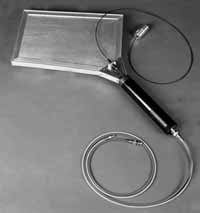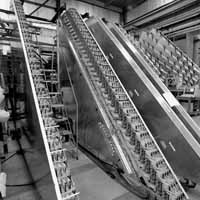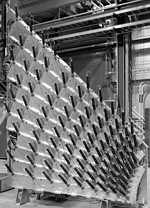 |
|
DZero Forward Muon System by Mike Perricone
Fermilab physicist Dmitri Denisov, who grew up in Russia, likes to cite a favorite old Russian proverb: "The best time to have a spoon is before lunch." Or, if you want to eat, make sure you have something to eat with.
It's a rich image with a distinctive cultural slant on all those finger-shaking admonitions your grandmother gave you: Do your homework. A stitch in time. For want of a nail. Look both ways.
In particle physics, the muon is the homework, the stitch, the nailóand the spoon. If you want to feast on the rich soup discoveries that will be served up by Collider Run II of the Tevatron, make sure you have utensilsóand make sure they're the right utensils. You can't eat soup with a fork.
"Muons and electrons are the only charged leptons which can easily be identified in a particle physics detector," explained Harry Weerts, project manager for the complete DZero upgrade, co-spokesperson for the collaboration, and a professor at Michigan State University.
"The only other charged lepton that exists is the tau," Weerts continued, "but the tau lives fast and dies young. It decays before you can ësee' it, so you are left with electrons and muons. For that reason, essentially every detector in particle physics MUST be able to identify and measure muons and electrons."
The muon system tracks and measures the behavior of muons in the detector's magnetic field. Muons are heavy; their mass is about 106 million electron volts (MeV), compared to about 0.5 MeV for the electron. In relativistic terms, muons are comparatively long-lived at 2.2 microseconds (millionths of a second). They have the mass and lifetime to penetrate great thicknesses of absorber material within a detector without losing much energy or experiencing any significant change in trajectory.
When all the other decay products are absorbed in the central areas of the detector, muons are left traveling to the detector's outer reaches, about 10 meters (33 feet) from the collision region. The muon systems, located symmetrically at each end of the big detector, chart the direction and energy of these emergent final products, then mathematically reconstruct the trail back to their origins.
"In other words, a muon is a sign of an unusual state of matter produced in the primary proton-antiproton collision inside the DZero detector--which is most interesting, of course," said Leonid Vertogradov with a physicist's characteristic understatement.
The forward muon system assembly was completed on-time on August 24, closing the circle begun in 1994 with the first discussions of a new concept at DZero for handling the increased numbers and rates of collisions in Collider Run II of the Tevatron. The large-scale production of muon system components began in 1998 at Dubna and Protvino, and at Fermilab. The total surface area of the two systemsótrigger detectors and minidrift tubesócovers some 800 square meters, or nearly two football fields. Together, they weigh 50 tons.
"These are large, very precise detectors," Denisov said, "built on a very limited budget on a very short time scale in different places in the world."
But not without headaches. Because reality is usually wackier than proverbs, and even with Fermilab's institutionally ingrained microscopic vision for detailóall the spoons and stitches and homeworkóthere were still some outside-the-box migraines:
"It was the best deer season in years. We couldn't reach anyone at the company, everybody went deer hunting for a couple of weeks," said Denisov, summing up the first headache and going on to the others.
The shipping was one of the few glitches in the Russian connection, and it was unrelated to the collaboration's top-notch technical work.
"In 1997, people were skeptical about shipping major detectors to be built in Russia," Denisov admitted. "We didn't know the future of the political situation and we were concerned. But Russia provided the equipment. Everything was done on budget and on time. Russia also provided funds, about $350,000, mostly from Dubna and Protvino."
And as for the other headache, that big company with the famous name?
"That last problem," Denisov said, somehow still smiling. "We bought about 250 kilometers, or 160 miles, of 50-micron gold-plated wire, which we'd bought from this company for many previous experiments. But when we shipped this wire to Dubna, Russia, for assembly, the gold was peeling off. After three or four months of trying to figure it out, we went to the company and learned that the engineer in charge of that particular operation had left after more than 15 years, and they weren't able to make the wire the same way he had always done it. But they kept trying and solved the problem."
The minidrift tubes--in effect, a coordinate system using some 50,000 lengths of that gold-plated wiring--reconstruct the tracks of the muons and measures their momentum when they strike the tubes, with the wires recording the change in electrical conductivity of the gas within. The mindrift tubes are also called "Iarocci tubes," after the Italian physicist who developed detectors of this type suitable for mass production about 25 years ago. They are made up of individual cells (1/2 inch by 1/2 inch by 20 feet in length), which measure the position of a muon crossing the wires to an accuracy of 500 microns (millionths of a meter). An electronic chip (produced in Belarus) amplifies the signals from each wire of the tube.
The trigger detectors, using scintillation counters, must observe each particle event very quickly (within 100 nanoseconds) decide, "Is there a muon in this event?" They were built at IPHEP-Protvino by a group led by Sergei Denisov (father of Dmitri Denisov). Individual detectors are overlapped to form a continuous plate in a "fish scale" design adapted by Valery Evdokimov of Protvino, and Fermilab's Andrew Stefanik of Particle Physics Division's Engineering and Tech Teams. There are 4,608 individual scintillation counter detectors, combined into eight "octants" which are assembled into a circular plane. In all, there are 96 octants, 48 for each type of detector, making up six complete sets.
The completed project celebrated not with lunch and a spoon but with a party, a fitting scene for that Russian toast, which translated literally, means "For everybody, health!"
"In two short words," said Denisov, "you can express a lot to your friends and colleagues, and to the experiment itself."
Na zdorov'e!
Forward muon system project manager Dmitri Denisov cited invaluable contributions from Muon Group co-managers Tom Diehl, Ken Johns and John Butler; from Darien Woodís group at Northeastern University and Henry Lubattií s group at the University of Washington, as well as the Fermilab engineers Andrew Stefanik and Anthony Levand; physicists Linda Stutte and Al Ito; and the DZero technical support group.
"We had large groups from different universities, labs and countries," said Denisov, "with people ranging from distinguished professors to graduate and undergraduate students to high school teachers taking their turns to work with tools. And we always felt strong support from the collaboration management, the Particle Physics Division and the Fermilab Directorate."
|
| last modified 9/15/2000 email Fermilab |
FRLsDFx9eyfrPXgV
 The muon, fat and long-lived cousin of the better-known electron in the lepton family, is an important "tag" used by physicists in tracing decay processes back to their origins--origins that might include new discoveries. Every part is critical in a 5,500-ton detector with a million electronic data channels, but the upgrade for the DZero Forward Muon System fills an essential role in the 500-member collaboration's ability to conduct sound particle physics experiments.
The muon, fat and long-lived cousin of the better-known electron in the lepton family, is an important "tag" used by physicists in tracing decay processes back to their origins--origins that might include new discoveries. Every part is critical in a 5,500-ton detector with a million electronic data channels, but the upgrade for the DZero Forward Muon System fills an essential role in the 500-member collaboration's ability to conduct sound particle physics experiments.
 The DZero forward muon system project has a distinctive Russian cast to it. Denisov is the project manager. Vertogradov is one of 16 members of the group from the Joint Institute for Nuclear Research in Dubna, near Moscow. The group, led by Gena Alexeev, was the key player in designing and fabricating the minidrift tubes, one of two detector types in the muon system, a six-year, $3.5-million project. The minidrift tubes reconstruct an event, while the trigger detectors, built at the Institute for High Energy Physics at Protvino in Russia, identify an event.
The DZero forward muon system project has a distinctive Russian cast to it. Denisov is the project manager. Vertogradov is one of 16 members of the group from the Joint Institute for Nuclear Research in Dubna, near Moscow. The group, led by Gena Alexeev, was the key player in designing and fabricating the minidrift tubes, one of two detector types in the muon system, a six-year, $3.5-million project. The minidrift tubes reconstruct an event, while the trigger detectors, built at the Institute for High Energy Physics at Protvino in Russia, identify an event.
 "When the Russian government changed the customs regulations," Denisov continued, "we were able to hold the container of Russian built components in Finland in the cold for two months. We were keeping our fingers crossed while we got new paperwork done, but everything survived the cold. We couldn't have done it without great work from Fermilab Shipping and Receiving, from Purchasing and from all the DZero secretaries."
"When the Russian government changed the customs regulations," Denisov continued, "we were able to hold the container of Russian built components in Finland in the cold for two months. We were keeping our fingers crossed while we got new paperwork done, but everything survived the cold. We couldn't have done it without great work from Fermilab Shipping and Receiving, from Purchasing and from all the DZero secretaries."
 The triggers and minidrift tubes are paired up and installed at the DZero detector in three layers: one layer in front of the muon toroid magnet, and two behind the magnet. Octants were assembled at Fermilab's Lab F, which needed a new door to handle the size of the frames and completed components. The Surveying Group made the critical measurements for accuracy using optical targets affixed to the frames. Detectors were mounted on the support frames, covered with a protective skin, and then fitted with cables and electronics for testing and calibrating at Lab F.
The triggers and minidrift tubes are paired up and installed at the DZero detector in three layers: one layer in front of the muon toroid magnet, and two behind the magnet. Octants were assembled at Fermilab's Lab F, which needed a new door to handle the size of the frames and completed components. The Surveying Group made the critical measurements for accuracy using optical targets affixed to the frames. Detectors were mounted on the support frames, covered with a protective skin, and then fitted with cables and electronics for testing and calibrating at Lab F.